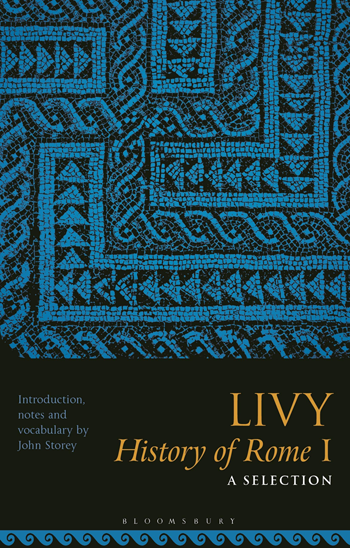
Storey's commentary is another of the OCR-endorsed editions for their prescribed texts, of which Livy's Ab Urbe Condita Book I will be examined in 2023–24. After a number of cycles, a teacher may have several of these on their shelf; Storey's contribution joins them happily, containing everything necessary for a teacher to introduce the text and its context, or indeed for a student to conduct their own independent preparation.
Storey's introduction is comprehensive, with sections on Livy's life and times (pp.1–6), a detailed summary of the contents of Book I (pp.6–10), and a particular focus on the character of Tarquinius Superbus (pp.11–12). The family tree of the text's ‘main players’ (p.10) is a good idea, though could have been laid out more clearly to show which are the primary and secondary characters, and not consistently giving praenomina and nomina (and cognomina where relevant) is an unhelpful omission. The section on Livy's style (pp.12–13) is brief but beneficial. Attention is drawn specifically to long sentences and his employment of direct and indirect speech, both staples of Livy's style, while also among the most challenging features for a post-GCSE student to translate. At the end of the book, there is a comprehensive vocabulary list (pp.73–95).
Storey finishes his introduction with a bibliography. Most of the works recommended are general introductions to Livy, historiography, or certain periods of history, and therefore perhaps of less benefit to the student than to the teacher, who will be better equipped to extract the sections relevant to study of Book I. For historical context, Storey recommends books on the regal period, as well as on the age of Augustus. This is in line with the OCR A level specification (‘Learners should be able to understand and appreciate, as appropriate, the social, cultural and historical contexts for the set texts, their authors and audiences.’) That said, only two books are recommended for Early Rome, while Storey offers six for the Augustan period. Are we to make of this that OCR is seeking more comment and analysis with reference to Augustus and the Principate, rather than the regal period? If this is the case, then Storey's commentary which follows could be considered lacking, as it makes minimal reference to the specific parallels between the text and Livy's own times.
In the main, Storey's commentary is written appropriately for an A level audience, often referring readers on to Morwood's Latin Grammar (1999), which is readily available online. He also makes a point of breaking down the specifics of Livy's style, consistently indicating where he is employing indirect speech, though it would be slightly more useful if Storey didn't refer to indirect speech/oratio obliqua interchangeably. Storey also points out almost all of the instances of historic presents, although these are less difficult to spot. Occasionally Storey does give comments which are straightforward, obvious even, such as glossing stricto gladio as ‘Ablative Absolute, “with his sword drawn”’(p.52), or inertium querellarum as ‘Genitive Plural – “useless complaints”’(p.62).
As ever, these Bloomsbury commentaries are intended to offer peace of mind to the teacher and student, armed with everything necessary for the A level specification. Storey is conscientious in glossing anything which could catch out an intermediate reader, but rarely ventures to offer interpretation beyond the power of a chiasmus or tricolon. Here the teacher will need to prepare their own resources, particularly with regard to the context of Augustan Rome. Nevertheless, with all other commentaries on Book I rare and/or outdated, this is worth buying.




